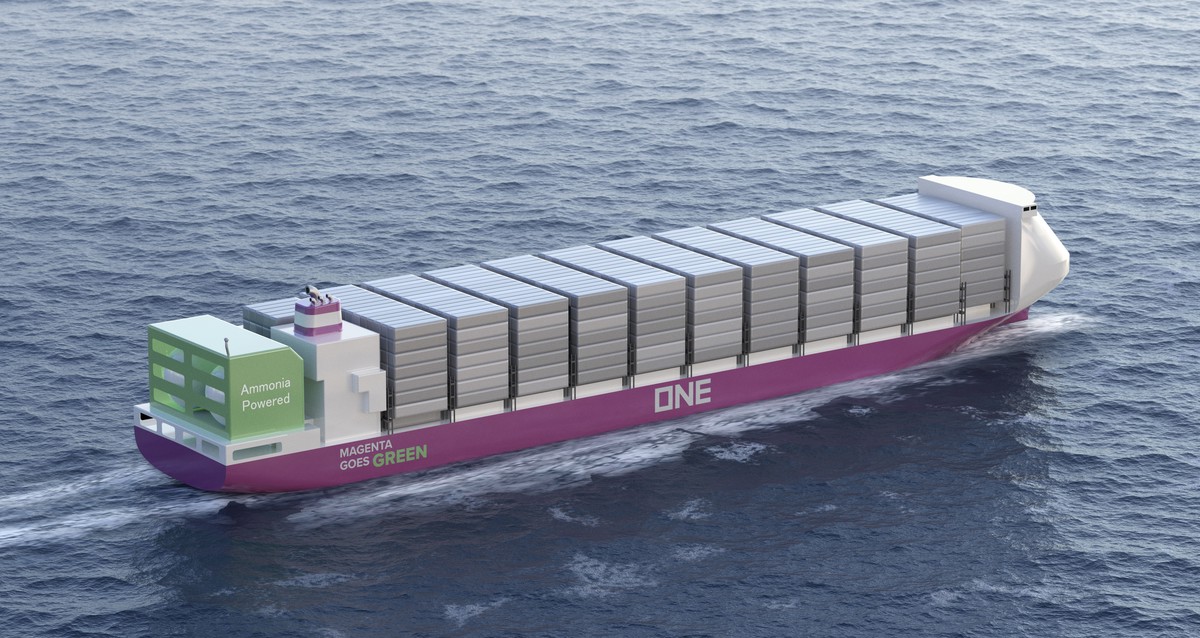Green ammonia can eliminate up to 80% of vessel emissions - SGMF
Green ammonia as bunker fuel can reduce shipping emissions by 61-80% on a well-to-wake basis, compared to conventional fuels, an SGMF-commissioned study has revealed.
 PHOTO: Concept of an ammonia-capable dual-fuel vessel. Nihon Shipyard
PHOTO: Concept of an ammonia-capable dual-fuel vessel. Nihon Shipyard
The study was commissioned by marine-focussed consortium the Society for Gas as a Marine Fuel (SGMF) and conducted by risk management firm Sphera. SGMF consortium partners include A.P. Moller-Maersk, Caterpillar, Crowley, Equinor, Fortescue and several other major companies from marine and oil and gas industry.
Green ammonia produced using renewable electricity sources as input can reduce greenhouse gas (GHG) emissions by up to 61% on a well-to-wake (WtW) basis, compared to VLSFO, the study estimates.
Blue ammonia can reduce GHG emissions by 20-31% compared to VLSFO on a WtW basis. Grey ammonia produced through pyrolysis from natural gas is estimated to have 16-27% lower GHG emissions than VLSFO.
Green ammonia is produced by combining green hydrogen with nitrogen obtained from the air through the Haber-Bosch process. Both hydrogen generation and Haber-Bosch processes are theoretically powered by renewable energy in this production method.
Blue ammonia is typically blue hydrogen combined with nitrogen captured from the air and put through the so-called Haber-Bosch process. The hydrogen is actually fossil as it is produced from steam methane reforming or autothermal reforming of natural gas. But the carbon dioxide (CO2) emitted during this production process is captured, which can render it low- or zero-carbon.
Unlocking ammonia’s lowest emission potential
Green ammonia has the lowest emission potential compared to blue or grey ammonia. However, making it fully emission free will require major technological advancements, the study highlights.
This is because ammonia as a bunker fuel does not emit CO2 but its combustion releases nitrogen oxides (NOx) emissions. Besides, ammonia as a fuel requires a pilot fuel for ignition because its high auto-ignition temperature makes it difficult to burn readily or sustain combustion. This can also cause CO2 and sulphur oxide emissions depending on the type and quantity of pilot fuel.
Two-stroke ammonia combustion engines may need around 5-20% of pilot fuel, while four-stroke engines may require as much as 30%.
“The combustion of Ammonia and pilot fuel results in 189 g CO2-eq/kWh, regardless of the production route. Around 70% (133 g CO2-eq/kWh) of greenhouse gas emissions from combustion are N2O, with 99.9% coming from Ammonia combustion. The remaining 30% (56 g CO2-eq/kWh) of GHG emissions are CO2 resulting from the combustion of the pilot fuel,” the study argues.
According to the study, green ammonia is capable of reducing WtW GHG emissions up to 80% by reducing pilot fuel consumption, using biofuel instead of diesel, and integrating NOx reduction technology into engines.
The study suggests that selective catalytic reduction (SCR) technology can reduce NOx emissions. Several ammonia-fuelled engines currently under development, including those from Wartsila, MAN Energy Solutions (MAN ES) and WinGD, are integrating SCR technology.
Stumbling block with ammonia
Ammonia combustion can emit stray ammonia emissions, known as ammonia slip. Ammonia emissions can also be released due to leakage along the fuel supply from tank to engines on ships. These emissions have a negative impact on air quality and the environment, the study warns.
“Ammonia is toxic, corrosive, and hazardous to the environment and can be potentially life-threatening if inhaled. Direct greenhouse effects of ammonia can be neglected, since it decomposes in the atmosphere in a short time, but ammonia reacts with SOx or NOx and forms Particulate Matter (PM), aerosols, and N2O, which is a greenhouse gas,” the study warns.
MAN ES claims its ammonia engine will be equipped with a safety measure called the ammonia catch system to mitigate ammonia slip. WinGD claims its ammonia engines will have “leak detection systems, emergency shutdown systems, double wall barriers, ventilation, and fire suppression systems” to ensure safety when using ammonia.
“Currently, there are no regulations addressing ammonia emissions. However, as ammonia is toxic, flammable and corrosive, a high degree of alignment and harmonisation between international standardisation committees and local regulatory authorities is required to scale the production, bunkering, and use of ammonia as a marine fuel.”
By Konica Bhatt
Please get in touch with comments or additional info to news@engine.online





